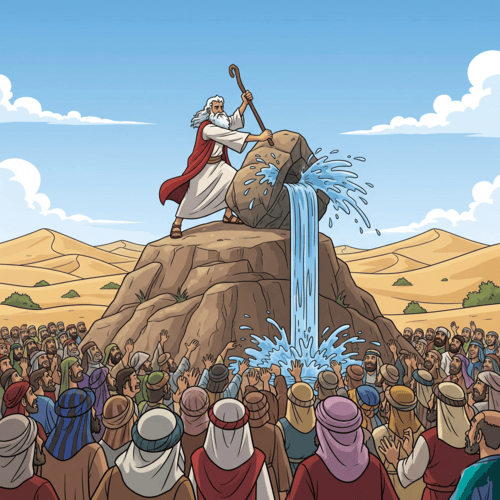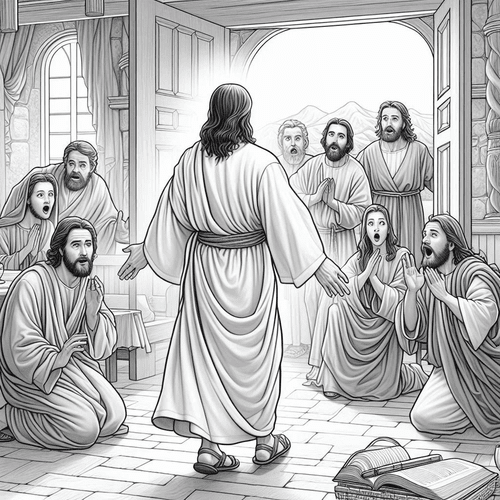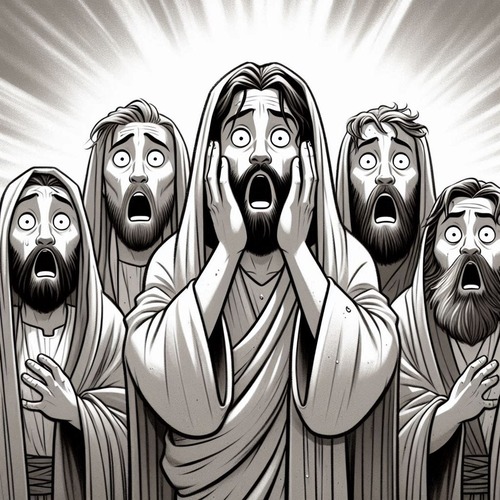The Rock Moses Struck: Finding Jesus in Exodus 17
The scene is desperate: two million Israelites dying of thirst in the wilderness, quarrelling with Moses, testing God’s patience. Then comes God’s command that seems almost bizarre: “Strike the rock, and water will come out of it for the people to drink” (Exodus 17:6). Moses obeys, water gushes forth, and Israel lives.
But what if this dramatic rescue was about far more than physical survival? What if God embedded a deeper spiritual meaning—what theologians call sensus plenior—into this historical event?
Sensus plenior refers to the fuller meaning intended by God in Old Testament texts beyond what the human author immediately understood. We see this pattern throughout Scripture: Isaac’s near-sacrifice foreshadowing God’s sacrifice of His Son, David’s psalms speaking prophetically of Christ’s sufferings, Jonah’s three days pointing to Christ’s resurrection, and the Passover lamb typifying Christ as the Lamb of God. Unlike eisegesis (reading into the text), this discovers what God actually wove into the fabric of redemptive history.
Exodus 17 is another stunning example where God embedded Christological significance into historical events—and we don’t have to guess about it, because the New Testament explicitly tells us this fuller meaning was truly intended.
THE APOSTOLIC KEY: “THAT ROCK WAS CHRIST”
Our confidence in seeing Christ in this passage doesn’t rest on creative interpretation but on inspired apostolic revelation. In 1 Corinthians 10:1-4, Paul writes: “Our fathers were all under the cloud, and all passed through the sea… and all drank the same spiritual drink. For they drank from the spiritual Rock that followed them, and that Rock was Christ.”
This isn’t Paul being metaphorical or allegorical. He’s making a direct typological identification under the inspiration of the Holy Spirit. The historical rock Moses struck was a divinely appointed type pointing forward to Christ Himself. Paul’s declaration gives us the interpretive key that unlocks the deeper meaning.
This follows the hermeneutical pattern Jesus established. On the Emmaus road, He showed the disciples “beginning with Moses and all the Prophets” how all Scripture points to Him (Luke 24:27). The apostles followed this same approach, seeing Christ throughout the Old Testament sacrificial system, in the bronze serpent, and here in the wilderness rock.
THE STRIKING: DIVINE JUDGEMENT SATISFIED
If the rock represents Christ, what does the striking signify? Here we discover one of Scripture’s most beautiful pictures of penal substitutionary atonement.
Moses, acting as mediator between God and the people, strikes the rock at divine command. This corresponds to Christ being struck by divine judgement on the cross—not by Moses’ rod, but by the Father’s wrath against sin. Isaiah captures this perfectly: “It was the will of the Lord to crush him; he has put him to grief” (Isaiah 53:10).
The rock had to be broken for the water to flow. Similarly, Christ’s body had to be broken—”This is my body, which is broken for you” (Luke 22:19)—for the rivers of living grace to flow to thirsty sinners. The strike wasn’t arbitrary violence but necessary judgement: it satisfied God’s justice while releasing God’s mercy.
Significantly, when Israel needed water again in Numbers 20, Moses was commanded to speak to the rock, not strike it. His disobedience in striking it again carries profound typological meaning: Christ died *once for all* (Hebrews 10:10-12). The striking was complete, never to be repeated. Now we simply speak to the Rock in prayer, and the water flows freely.
THE WATER: RIVERS OF LIVING GRACE
The water that gushed from the cleft rock wasn’t a mere trickle—it was abundant enough for two million people and their livestock. This abundance perfectly pictures the inexhaustible nature of gospel grace flowing from Christ’s sacrifice.
Jesus Himself made this connection explicit. At the Feast of Tabernacles, likely while the priests were performing the water-drawing ceremony commemorating this very miracle, Jesus cried out: “If anyone thirsts, let him come to me and drink. Whoever believes in me, as the Scripture has said, ‘Out of his heart will flow rivers of living water'” (John 7:37-39). John immediately clarifies: “Now this he said about the Spirit, whom those who believed in him were to receive, for as yet the Spirit had not been given, because Jesus was not yet glorified.”
Notice the beautiful theological sequence: just as Pentecost followed Calvary, the water followed the striking of the rock. The Spirit could not be given until Christ was first “struck” and glorified. The water at Meribah thus pictures the outpouring of the Holy Spirit—abundant, life-giving, flowing from the wounded Rock to sustain God’s people on their wilderness journey.
This interpretation finds further confirmation in Isaiah 44:3, where God promises: “I will pour water on the thirsty land, and streams on the dry ground; I will pour my Spirit upon your offspring.” Water and Spirit are consistently linked throughout Scripture as symbols of divine life and blessing flowing from God’s provision.
Even the account in John 19:34 of Christ’s crucifixion echoes this typology: “One of the soldiers pierced his side with a spear, and at once there came out blood and water”. From the cleft side of our Rock flows the water of life.
PASTORAL IMPLICATIONS: DRINKING FROM THE ROCK
This passage beautifully demonstrates how Reformed theology reads Scripture. We don’t impose meaning onto the text but discover the meaning God placed there, validated by Scripture’s own interpretation. The unity of redemptive history means Old Testament events weren’t merely historical but carried forward-pointing significance toward Christ.
For the believer, this passage offers profound comfort. When we thirst spiritually—whether for forgiveness, strength, or hope—may we remember the Rock has already been struck. Divine justice has been satisfied. The water flows freely from Christ’s wounded side. We don’t need to strike the Rock again; we simply speak to Him in faith, and drink deeply.
The God who provided water in the wilderness is the same God who provides living water today. The Rock Moses struck stands eternally cleft, and from it flows an endless river of grace for all who come to Jesus and drink.
In every drop of that wilderness water, God was painting a picture of His Son—the true Rock who’d be struck so rivers of living water might flow to quench the thirst of every believing heart.
THE ROCK MOSES STRUCK: RELATED FAQs
Is sensus plenior the same as typology? While closely related, sensus plenior and typology are distinct concepts. Sensus plenior refers to the fuller meaning God intended beyond what the human author understood, while typology specifically involves Old Testament persons, events, or institutions that prefigure New Testament realities. All typology involves sensus plenior, but not all sensus plenior is necessarily typological—some involves direct prophecy or symbolic language the human author may have partially understood.
- What other Old Testament passages demonstrate clear sensus plenior? Genesis 22 (Isaac’s near-sacrifice) beautifully foreshadows God’s sacrifice of His Son, complete with the mountain location and the substitutionary ram. Psalm 22 describes crucifixion details centuries before this method of execution existed, while Psalm 16:10 speaks of resurrection (“you will not let your holy one see corruption”). The bronze serpent in Numbers 21 provides another striking type, which Jesus Himself validated in John 3:14-15. These passages show God’s consistent pattern of embedding Christological meaning throughout redemptive history.
- How do contemporary Reformed scholars view the rock typology in Exodus 17? Leading Reformed theologians like Edmund Clowney, Graeme Goldsworthy, and Vern Poythress strongly affirm this typological reading based on Paul’s explicit statement in 1 Corinthians 10:4. Systematic theologians like Wayne Grudem and Michael Horton emphasise such interpretations must be grounded in New Testament authorisation rather than creative speculation. The Westminster Seminary tradition particularly champions this approach as consistent with the analogia scriptura (Scripture interprets Scripture) principle. Contemporary theologians argue that rejecting such clear apostolic interpretations undermines the unity of Scripture and the legitimacy of typological hermeneutics.
- Why did Moses disobey by striking the rock twice, and what does this teach us? In Numbers 20, God commanded Moses to speak to the rock, not strike it, yet Moses struck it in anger. This disobedience carried profound typological significance: Christ needed to be struck only once for our redemption (Hebrews 10:10-12). Moses’ second striking violated the picture of Christ’s once-for-all sacrifice and demonstrated that even the mediator under the old covenant was imperfect. This incident ultimately cost Moses the privilege of entering the Promised Land, showing God’s holiness even toward His chosen servants.
How does the “spiritual rock that followed them” relate to Christ’s eternal presence? Paul’s phrase “the spiritual Rock that followed them” (1 Corinthians 10:4) has sparked theological discussion about Christ’s pre-incarnate activity. Reformed theology understands this as referring to the ongoing spiritual provision that flowed from that initial striking, sustained by the pre-incarnate Christ throughout Israel’s wilderness journey. This doesn’t mean a literal rock rolled behind the Israelites, but that Christ was spiritually present, providing ongoing sustenance through the water that continued to flow. It beautifully pictures how Christ continues to sustain His people throughout their earthly pilgrimage.
THE ROCK MOSES STRUCK: OUR RELATED POSTS
Editor's Pick
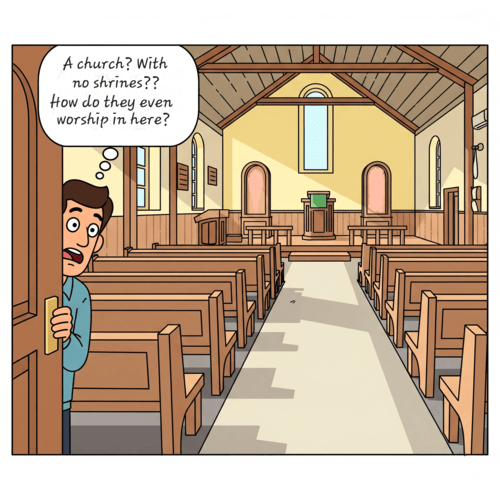
Do Christians Need Holy Shrines? Why the Reformed Answer Is No
Walk into a medieval cathedral and you'll encounter ornate shrines, gilded reliquaries, and designated "holy places" where pilgrims gather to [...]

I Want To Believe, But Can’t: What Do I Do?
"I want to believe in God. I really do. But I just can't seem to make it happen. I've tried [...]
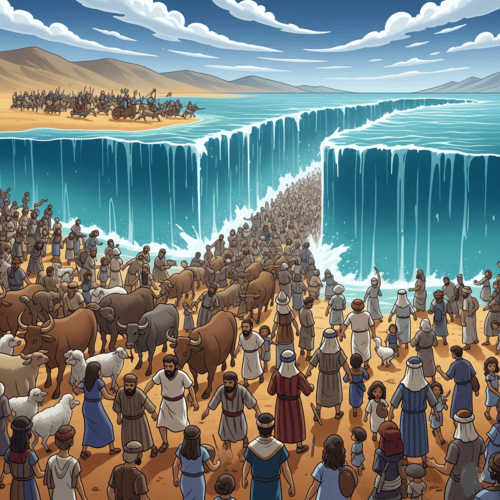
BC 1446 or 1250: When Did the Exodus Really Happen?
WHY REFORMED SCHOLARS SUPPORT THE EARLY DATE Many a critic makes the claim: “Archaeology has disproven the biblical account [...]

Does God Know the Future? All of It, Perfectly?
Think about this: our prayers tell on us. Every time we ask God for something, we’re confessing—often without realising it—what [...]

Can Christian Couples Choose Permanent Birth Control?
Consider Sarah, whose fourth pregnancy nearly killed her due to severe pre-eclampsia, leaving her hospitalised for months. Or David and [...]

Bone of My Bones: Why Eve Was Created From Adam’s Body
"This at last is bone of my bones and flesh of my flesh!" Adam's joyful exclamation upon first seeing Eve [...]

Is Calvinism Fatalism in Christian Disguise? Think Again
We hear the taunt every now and then: "Calvinism is just fatalism dressed up in Christian jargon." Critics argue Reformed [...]

Can Churches Conduct Same-Sex Weddings?
In an era of rapid cultural change, churches across America face mounting pressure to redefine their understanding of marriage. As [...]

Gender Reassignment: Can Christian Doctors Perform These Surgeries?
In the quiet of a clinic, a Christian physician faces a challenging ethical question. A patient sits across the desk, [...]

‘What Sorrow Awaits You Who Are Rich…’: What Does Jesus Mean?
The words hang in the air like a sword over comfortable Christianity: “What sorrow awaits you who are rich, for [...]
SUPPORT US:
Feel the Holy Spirit's gentle nudge to partner with us?
Donate Online:
Account Name: TRUTHS TO DIE FOR FOUNDATION
Account Number: 10243565459
Bank IFSC: IDFB0043391
Bank Name: IDFC FIRST BANK


